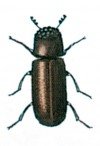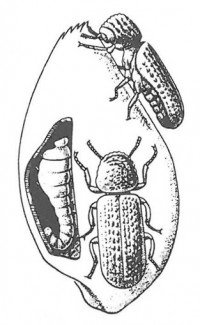

Latin: Rhyzopertha dominica.
2 – 3 mm long, reddish-brown to black-brown beetle. The prothorax is large and rounded in front like a hood, which on the top and in the front is covered with small lumps. The lumps help when the beetle drills. Head with mouth parts is on the underside of the prothorax and is not seen from the back. Feelers are 10-jointed and the three outer joints form a thick-toothed comb.
In the tropics, it is a dreaded pest of wheat, corn, rice, millet, etc. It is quite rare in Northern Europe, but is sometimes found in imported goods. In order to develop and reproduce it requires temperatures greater than 21 ° C. It is therefore only harmful in very warm stocks. Both larvae as well as beetles bore irregular perforations in kernels. Heavily infested items become dusty from the insect drilling and have a distinctive, strong honey smell. Extermination can be done by cooling the products or by using poison gas.




